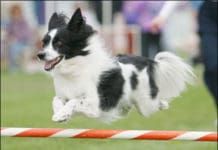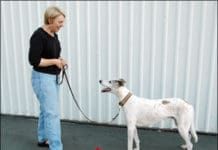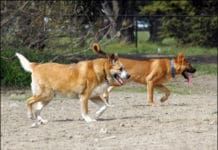Home Search
allergies/feed/rss2/Rawhide%20chews%20are%20potentially%20dangerous%20because%20they%20can%20be%20a%20choking%20hazard%20or%20cause%20gastrointestinal%20obstructions%20if%20your%20dog%20manages%20to%20chew%20off%20a%20piece%20that%20is%20small%20enough%20to%20swallow,%20but%20too%20large%20to%20pass%20unimpeded.%20In%20addition,%20some%20rawhide%20chews%20are%20hard%20enough%20to%20break%20or%20damage%20teeth. - search results
If you're not happy with the results, please do another search
Fear-Free Dog Training Methods
or threatening his general well-being if he made the wrong move. It wasn't fear of punishment or fear of me or some sort of amorphous "respect" that he had for me
Victoria Stilwell Promotes Positive Dog Training on Television
and then it means leash jerk! The dog's not learning to walk close to me because he wants to, he's learning to walk close to me because he fears what's going to happen to him if he doesn't. I have to say this was a long, long, time ago. I thought, This is bizarre
Installing Safe and Affordable Fencing for Dogs
There was a time when no one thought twice about letting their dogs roam the neighborhood. A fenced yard was almost unheard of. If you grew up in the 1950s and '60s as I did, you may remember those times. Dogs were well socialized, loved kids, and it was no big deal when the neighbor's dog came over and visited your female dog in season. Of course, they also chased cars, got pregnant a lot, and occasionally although rarely bit someone. You may also remember, as I do, a long list of childhood pets who got shot, hit by cars, or simply vanished, having fallen victim to who knows what fate. Today, our canine companions are more likely to be spayed or neutered, vaccinated, and responsibly contained. As a result, they tend to live safer, longer lives. But having a fence isn't always the be-all, end-all solution that it seems to be. Fences can bring on a host of challenges that our parents never faced with the family dog a generation ago.
Selecting Your Next Dog or Puppy
Thinking of getting a new dog? Chances are you're inundated with well-intentioned advice from every friend, family member, and canine professional you know about where to go and who to avoid in your quest to find your next canine pal. You may also feel the added burden of finding the right dog - one who will be as close to perfect as caninely possible. It's an awesome challenge. Many years ago, I was living on my own for the first time, and missed having a dog in my life. I went on a Collie search, and soon answered an ad in the paper for Marty's Pride, a tri-color Rough Collie whose owner had gone off to college. Marty was near canine-perfect: the first dog I showed in AKC obedience competition (he earned his Companion Dog title in three trials with scores of 194.5, 196, and 197), and the first dog I ever owned who died of old age. He was also the last dog I deliberately went looking to adopt. Since then my selections have been much more serendipitous. My husband and I tend to adopt the dogs who find us, or we trip over them at the shelter and bring them home. I realize that we're the exception, not the rule. Most people make more deliberate decisions than we do about the kind of dog they want, and where to find him - or her. Those decisions, although deliberate, are not always wise. I'm constantly amazed by the number of clients in my behavior consultation practice who thought they were making well-educated, well-researched decisions about the acquisition of their new four-legged family member, and ended up with something vastly different from what they expected. So how do you make an educated, responsible decision about selecting your next dog?
Canine Swimming Lessons: The Perfect Exercise For Your Dog
For those of us who regularly swim for fitness, we know why swimming is often referred to as “the perfect exercise.” In addition to the physical benefits shared with other forms of aerobic exercise, swimming offers some unique benefits. It eliminates the effects of weight-bearing on the joints, exercises the entire body – upper and lower – at the same time, and, in most cases, is something we can do for our entire lives, even if age precludes us from taking part in other forms of exercise. The physical benefits of swimming are the same for your canine companion as they are for you – that is, if you have a dog who will swim. Even though they actually have a stroke named after them, the notion that all dogs are “natural swimmers” is an erroneous one. Some breeds were developed to work in water and are more physically adapted for swimming than others. The problem here is not getting these dogs into the water, but keeping them on terra firma when we want them to stay clean and dry. However, occasionally, even a water breed shows disdain for water – yes, there are some Labrador Retrievers who hate swimming. Conversely, there are dogs you’d never imagine taking kindly to the water who become devoted and skilled swimmers. Although not blessed with the physical advantages of a water breed, and despite sinking rear ends or heavy, wet coats, these Boston Terriers, Rhodesian Ridgebacks, and Siberian Huskies have learned to enjoy swimming. They don’t know or care that they have to work a little harder than a Poodle, Cocker Spaniel, or a Newfoundland – they just want to have fun!
Solutions for Reactive Dog Behavior
At some point in our lives, some of us find ourselves living with a difficult dog, one whose behavior challenges our patience, and exhausts our training knowledge – and opens our hearts and eyes to a new, better way of training. This is the story of one such dog and her very knowledgeable dog owner. Together, they reached an entirely new and higher level of dog training skills, thanks to the owner’s life-altering experiences with a reactive dog who wasn’t fit to compete in the career intended for her: Flyball. Flyball is not the sport for everyone. It is a relay team event, which means you have to commit to training and competing with your dog and other dogs and dog owners as a team, and you have to have an appreciation for over-the-top dogs and the resulting cacophony of sounds. In flyball, a team of four dogs race, one after the other, leaping a series of hurdles, throwing their bodies against a spring-loaded box that ejects a tennis ball, snatching the ball, and hurtling their bodies back down the row of jumps to where their next teammates strain to be released for their turns. The fastest team wins.
Kennel Cough Treatment and Prevention
Anyone who's heard it will recognize the dry, hacking, something's-stuck-in-my-throat cough that won't quit. It's the signature symptom of canine infectious tracheobronchitis, also known as Bordetellosis, Bordetella, and most commonly as kennel cough. Whatever you call it, tracheobronchitis is one of the world's most widespread canine diseases. Like the common cold in humans, tracheobronchitis is highly contagious, rarely fatal, and runs its course in a few days. Fortunately, there are several ways to help make canine patients more comfortable, speed recovery, and prevent future infections. Tracheobronchitis is called kennel cough because of its association with boarding kennels, animal shelters, veterinary waiting rooms, grooming salons, and other areas where dogs congregate in close quarters. It can strike dogs of any age but is most common in puppies, whose immune systems are still developing, and adult dogs with conditions that impair immune function.
Teaching Your Dog to “Leave It” On Cue
mark the desired behavior with the click of a clicker (or the word "Yes!") and feed him a different treat.üPractice "Leave it!" with everything your dog likes in real life: food
How to Help With Separation Anxiety in Dogs
Fixing a dog's separation anxiety is hard work. It's all too easy to get frustrated with your dog's destructive behavior. Remember that he's not choosing to do it out of spite or malice - he is panicked about his own survival without you, his pack, there to protect him. It's not fun for him, either; he lives in the moment, and the moments that you are gone are long and terrifying. If you make the commitment to modify his behavior and succeed in helping him be brave about being alone, you'll not only save your home from destruction, you will enhance the quality of your dog's life immensely - as well as your own - and perhaps save him from destruction, too.
Train Your Dog to Greet People
Recently, I switched the group class format at my Peaceable Paws Training Center to Levels." Instead of a progressive curriculum with new exercises introduced each week
Mixed-Aged Dog Packs
Can older dogs and younger dogs live happily together? Will a puppy bounding around (and possibly on) the arthritic body of an older dog encourage her to be more active, bringing energy and vitality during senior years? Or will the perfectly normal antics of a young dog aggravate and stress what should be a time of happy retirement for a senior dog? If you've lived with an older dog, you've probably heard someone at some point recommend getting a puppy or younger dog. The advice may be something like, "It will keep your older dog young," or "The new puppy can learn from your older dog." While you will likely find some truth in both statements, the opposite may also hold true. Your older dog could be stressed or exhausted by a younger dog. Your young dog will certainly learn from your older dog, but the lessons may not be those you would like to be passed from one generation to the next.
The Dangers of Vinyl Dog Toys
which are made with natural rubber."













